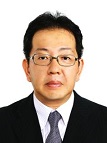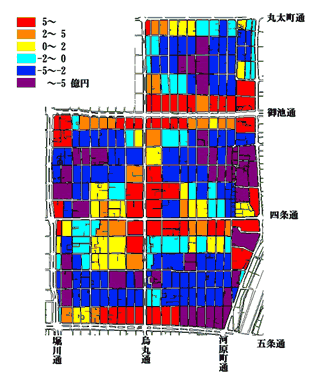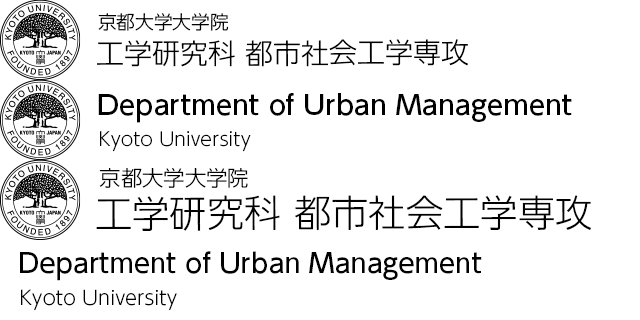Urban and Regional Planning
kyoto-u.ac.jp
Our research develops the theory to many problems occurred in cities and regions, such as land use, transportation, houses, and environment.
While performing phenomenon clarification to these urban problems, our researches aim at establishment of the methodology about the process from the creation of alternatives to decision-making stage.
Academic Staff
Nobuhiro UNO

Professor (Graduate School of Engineering)
In order for creating the safe, efficient and comfortable urban transport system, I have been studying the management and control schemes especially for road transport system into which IT is incorporated. My main research topics are an analysis of travel behavior under provision of dynamic information, a development of dynamic inflow control model for urban expressway and a microscopic analysis of traffic conflicts using video image data.
Contacts
Room 262, C1 Bldg. C Cluster, Katsura Campus
TEL: +81-75-383-3226
FAX: +81-75-383-3227
E-mail: uno.nobuhiro.2v kyoto-u.ac.jp
kyoto-u.ac.jp
Ryoji MATSUNAKA
 Associate Professor (Graduate School of Engineering)
Associate Professor (Graduate School of Engineering)
Research Topics
evaluation of urban transport policies, urban policy and environment, public transportation planning, urban transport simulation, sustainable society, activation of city and central city area, projects evaluation, travel behavior analysis, transport policy and funding, barrier free transport.
Contacts
Room 261, C1 Bldg. C Cluster, Katsura Campus
TEL: +81-75-383-3225
FAX: +81-75-383-3227
E-mail: matsunaka.ryoji.3v![]() kyoto-u.ac.jp
kyoto-u.ac.jp
Tomoki NISHIGAKI
Assistant Professor (Graduate School of Engineering)
Research Topics
Analysis of tourists' behaviour using big data, Connectivity between shared mobility and public transportation
Contacts
Room 263, C1 Bldg. C Cluster, Katsura Campus
TEL: +81-75-383-3228
FAX: +81-75-383-3227
E-mail: nishigaki.tomoki.6d![]() kyoto-u.ac.jp
kyoto-u.ac.jp
Research Topics
Urban amenities
Amenity is defined as the livability of a city, which includes three aspects. The first one is known as various social capitals, which support all actions in the city. They are comprised with natural environment, historical environment (cultural assets and historical climate), street views, sceneries, regional cultures, communities, transportation facilities, schools, parks, hospitals, and facilities for water supply and disposal. The second one is quantity and quality of diverse characters of a city, for instance, safety and relief. And the last but the same important one is a comprehensive value when all the above factors are spatially arranged, which people may have different idea about, according to diverse actions as living, playing, working, learning and moving.
In this laboratory we tackle researches subjecting city amenities as follows.
- Economic Estimation of Traditional Cultural Goods
- Economic Estimation for values of Historical Environmental Goods
- The Economic Evaluation of the ancient capitals preservation law based on the consciousness of citizen
- Economic analysis for valuation and conservation of Japanese traditional residences in Kyoto
- Continuous conservation value of Japanese traditional residences in Kyoto
- Effect analysis of Transfer of Development Rights (TDR) to conserve urban environmental stock
- Meanings and problems in Delphi’s CVM model with considering of studying processes
- Cost-Benefit analysis of road infrastructure construction reflect residents consciousness structure
- Measuring structure and wide sense benefits of road arrangement valuation
- A study on the optimum adjusting sequence of traffic barrier-free planning for supporting movement
- The Modeling the Structure of Transportation and cooperation on the Urban Infrastructure Equipment
- Transfer resistance at terminal in urban public transportation
- The Analysis of Structure of Temporal and Spatial Ripple Effect

Figure 1 Land prices change which is caused by Transfer of Development Rights(TDR).
Mobility and Environment
The concept “Sustainable Development” which the Brundtland Committee proposed in 1987 is, recently, the foundation for the policy planning in several countries.
The centralization of population and economy in cities is the globally trend. And now, the greater part of population, economy, and the consumption of resources belongs to urban areas. The globally “Sustainable Development” can not be meaningful and feasible without the improvement of elements in urban areas, such as structure, lifestyle, and economic activity.
We aim to search for the feature of “sustainable city”, analyzing the relationship among mobility, environment, and urban structure. We are doing research as follows.
- The impact of the policy of urban transportation on environment
- The analysis on relationship between the characteristic of a city and the level of energy consumption of urban transportation considering the level of mobility
- The comparative study of national statistics for CO2 emissions in the world

Figure 2 A road jammed by vehicles and a road occupied by pedestrian
Urban activities and transport
In our lab, diverse researches relating urban planning and transportation planning are carried out, focusing on transportation facilities, which are considered as very important infrastructures to support activities in a city.
- Optimization of the gradual construction process of a traffic network.
- Influence and effect that a broader-based traffic project affects international traffic demand.
- Evaluation of traffic project in consideration of the characteristic of the interurban public traffic
- International comparison of traffic institution maintenance source by paying attention to the shift of composition of those who pay a tax
- Creation of the verification system of regional disaster prevention plan in consideration of the activity distribution in the city, in case of earthquake
- Transport planning in consideration of people’s special and temporal distribution, in the case of earthquake
- Assessment of transportation policy considering uncertainty of required time and chain of transportation actions
- Measurement of benefit of construction of space to walk
- The development of the simulation of urban transportation for comprehensive estimation of the polity of urban transportation
- The revitalization of the C.B.D
- The Estimation of Reallocation of Road Space in the C.B.D
- The Estimation of Measures to improve Problems of the P.F.I Project

Figure 3 Traffic project valuation system(highway network in Japan)
